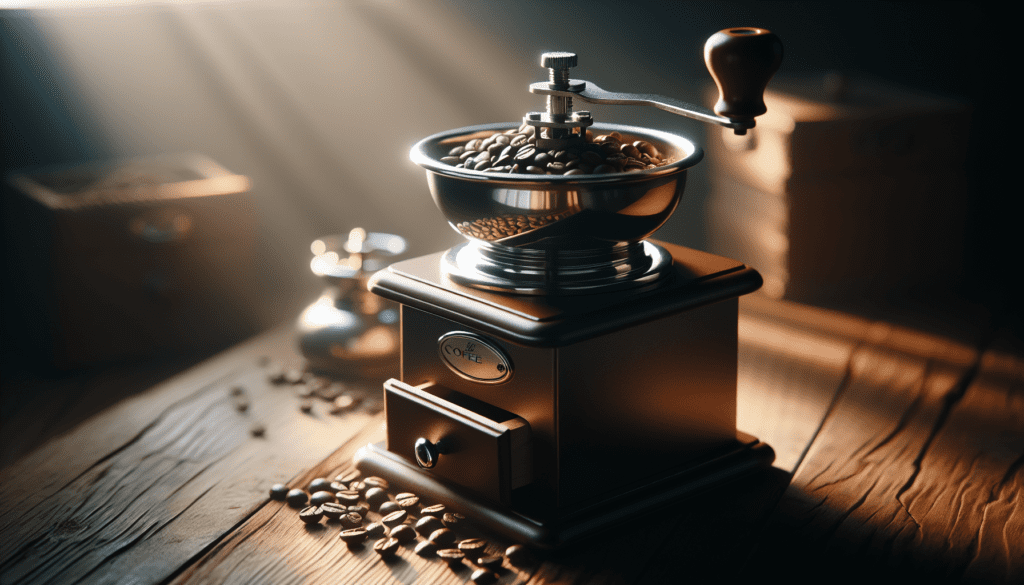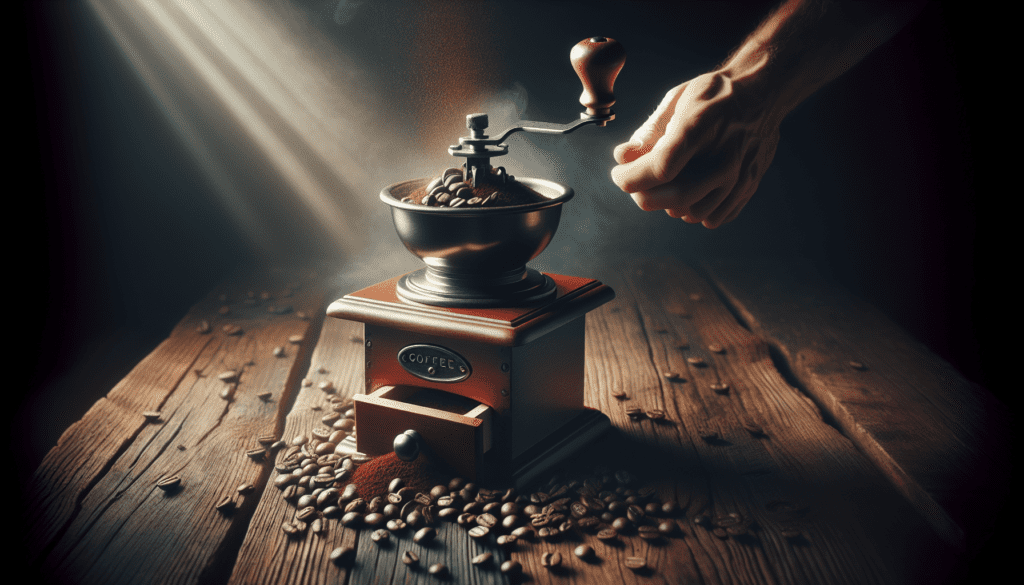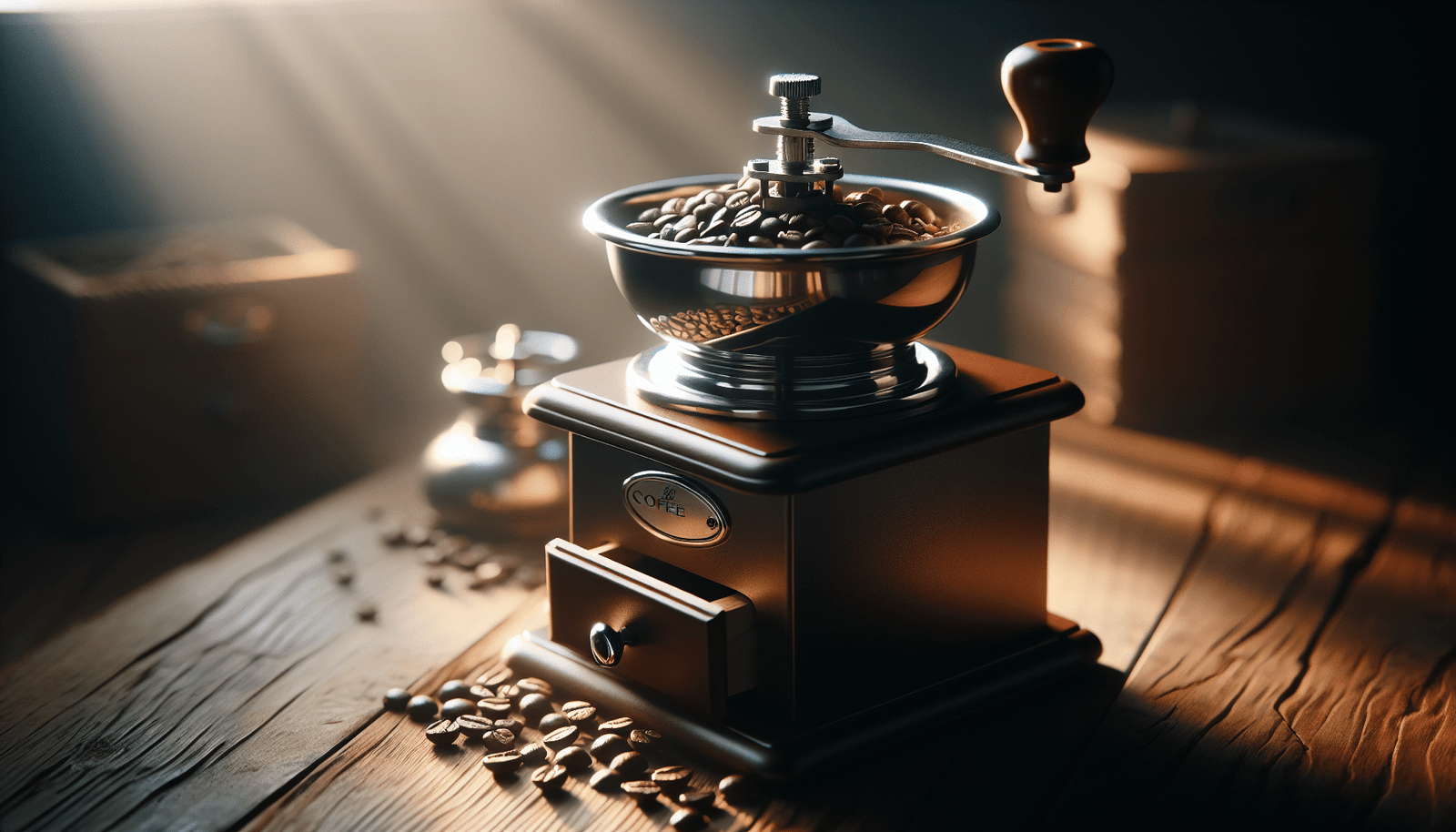Are you ready to embark on a flavorful journey through the world of coffee beans? From the origins of these aromatic gems to the various ways to grind them, we’ll explore it all. Whether your taste buds crave the boldness of arabica beans or the smoothness of decaf, we’ll guide you on the perfect way to store and preserve their freshness. Delve into the art of home roasting and discover the gourmet world of flavored beans. With our help, you’ll find the best coffee beans for your preferred brewing method, ensuring a rich and satisfying cup every time. So grab your grinder, and let’s dive into the wonderful world of grinding coffee beans.

Understanding the Importance of Grinding Coffee Beans
Grinding coffee beans is a crucial step in the coffee brewing process. The size of the grind plays a significant role in the extraction of flavors from the coffee grounds. Understanding the importance of grinding coffee beans will help you achieve a delicious cup of coffee with your desired flavor profile.
The role of grind size in coffee extraction
The grind size of coffee beans determines the rate at which water extracts the flavors from the beans. A finer grind allows for a quicker extraction, while a coarser grind slows down the extraction process. It’s essential to find the right grind size for your brewing method to achieve optimal extraction.
How grind size affects the flavor of coffee
The grind size directly impacts the flavor profile of your coffee. Finer grinds tend to produce a stronger, more intense flavor, while coarser grinds result in a milder taste. By adjusting the grind size, you can tailor your coffee to your preferred strength and taste preferences.
The impact of grind size on different brewing methods
Different brewing methods require different grind sizes. For example, espresso machines require a fine grind to extract the full flavor and aroma from the coffee. On the other hand, a French press calls for a coarser grind to prevent over-extraction. Understanding how grind size affects each brewing method is essential for achieving the best results.
Various Grinding Methods
There are several methods of grinding coffee beans, each with its own advantages and disadvantages. Here are some common grinding methods you can consider:
Blade grinders
Blade grinders are the most basic and affordable option. They consist of a spinning blade that chops the coffee beans into smaller pieces. While blade grinders can get the job done, they often result in uneven grinds and can generate more heat, potentially affecting the flavor of the coffee.
Burr grinders
Burr grinders are considered the gold standard in coffee grinding. They use two revolving abrasive surfaces (burrs) to crush the coffee beans into consistent particles. Burr grinders offer precise control over grind size and produce more uniform grounds, resulting in a better extraction and a more flavorful cup of coffee.
Hand grinders
Hand grinders are manual devices that require a bit of elbow grease to operate. They are portable and offer excellent control over grind size. While hand grinding can be time-consuming, many coffee enthusiasts enjoy the process and appreciate the ability to adjust the grind to their liking.
Electric grinders
Electric grinders are a convenient option for those who want quick and effortless grinding. They are available in both blade and burr varieties and offer various grind settings for different brewing methods. Electric grinders are ideal for those who brew coffee frequently and prefer consistency in their grind.
Manual vs. automatic grinders
Choosing between a manual and automatic grinder depends on your personal preferences and brewing habits. If you enjoy the tactile experience of grinding coffee and want more control over the grind size, a manual grinder may be the right choice for you. If convenience and speed are crucial, an automatic grinder may be more suitable.
Choosing the Right Grinder
Selecting the right grinder can significantly impact the quality of your coffee. When considering a grinder, keep the following factors in mind:
Factors to consider when selecting a grinder
- Grind consistency: Look for a grinder that can produce consistent particle size to ensure even extraction.
- Grind settings: Consider the range of grind sizes the grinder offers to accommodate different brewing methods.
- Durability: Opt for a grinder made from high-quality materials that can withstand regular use.
- Ease of cleaning: Look for a grinder that is easy to disassemble and clean, as coffee residue can build up over time.
- Price range: Set a budget and find a grinder that offers the features you need within your budget.
Different types of grinders and their pros and cons
- Blade grinders: Pros – affordability, compact size. Cons – inconsistent grind size, potential heat buildup.
- Burr grinders: Pros – precise grind size, consistent results. Cons – higher price point, larger size.
- Hand grinders: Pros – portability, control over grind size. Cons – time-consuming, requires physical effort.
- Electric grinders: Pros – convenience, quick grinding. Cons – can be noisy, higher price range for quality options.
Budget-friendly grinder options
If you’re on a tight budget, there are affordable grinder options available. Blade grinders are typically more budget-friendly, but it’s essential to manage your expectations regarding grind consistency. Additionally, manual hand grinders can be a cost-effective option if you don’t mind putting in a bit of effort.
Grinding Techniques for Different Brew Methods
Grind size plays a vital role in determining the quality and flavor of your coffee. Here are some grind size recommendations for various brewing methods:
Grind size recommendations for espresso
Espresso requires a very fine grind to achieve the intense flavor and rich crema. Aim for a grind size similar to powdered sugar or fine sand. The fine grind allows for high-pressure water extraction, resulting in a concentrated and flavorful shot of espresso.
Optimal grind size for pour-over coffee
Pour-over coffee methods, like the V60 or Chemex, require a medium-fine to medium grind size. This allows for a balanced extraction, allowing the water to flow through the coffee grounds at an ideal rate. The grind size should resemble granulated sugar or sea salt.
French press grind size guidelines
French press brewing calls for a coarse grind to prevent over-extraction. The coarse grind allows for longer steeping times without resulting in a bitter taste. Aim for a grind size similar to coarse sea salt or breadcrumbs.
Grind size tips for cold brew
Cold brew requires a coarse grind to minimize the extraction of bitter compounds. The larger grind size allows for longer steeping times without over-extracting undesirable flavors. Aim for a grind size similar to coarse sea salt or cracked peppercorns.
Adjusting grind size for AeroPress brewing
AeroPress offers versatility when it comes to grind size. For a shorter brewing time and a stronger cup, use a finer grind similar to table salt. Alternatively, for a longer extraction and a milder cup, opt for a coarser grind similar to breadcrumbs.

Steps to Grind Coffee Beans
Properly grinding coffee beans involves a few key steps to ensure optimal flavor extraction. Follow these steps for the best results:
Measuring the correct coffee-to-water ratio
Start by measuring the right amount of coffee based on your desired brew method and serving size. A general rule of thumb is to use approximately 1 to 2 tablespoons (7 to 14 grams) of coffee per 6 ounces (177 milliliters) of water. Adjust the ratio according to your taste preferences.
Preheating and setting up the grinder
If using an electric grinder, preheat it by running it for a few seconds before grinding the coffee beans. This helps reduce heat buildup during the grinding process. Make sure the grinder is clean and set to the desired grind size for your brewing method.
Selecting the appropriate grind size
Refer to the recommended grind sizes for your specific brewing method and adjust the grinder accordingly. Pay attention to the texture and consistency of the coffee grounds to ensure they align with the desired grind size.
Grinding coffee beans in small batches
For the best flavor, grind your coffee beans in small batches just before brewing. This helps to preserve the aromatic oils and prevent flavor loss. Avoid grinding coffee beans in advance as they can quickly oxidize and lose their freshness.
Storing the ground coffee properly
If you have leftover ground coffee, store it in an airtight container away from light, heat, and moisture. Ground coffee is more susceptible to oxidation, which can lead to flavor degradation. It’s best to use the ground coffee within a week for optimal flavor.
Troubleshooting Common Grinding Issues
Even with the best equipment, sometimes issues can arise during the grinding process. Here are some common grinding issues and how to address them:
Over-extraction and under-extraction problems
If your coffee tastes too strong or bitter, it may be over-extracted. Adjust the grind size to be coarser, allowing for a slower extraction. On the other hand, if your coffee tastes weak or sour, it may be under-extracted. In this case, adjust the grind size to be finer for a quicker extraction.
Uneven grind distribution and its effects
Uneven grind distribution can lead to uneven extraction, resulting in inconsistencies in flavor. To address this issue, consider investing in a burr grinder as they provide a more uniform grind. Additionally, make sure to distribute the coffee grounds evenly in the brew device to promote even extraction.
Addressing clogging and jamming in grinders
If you experience clogging or jamming in your grinder, it may be due to excessive fines or oil buildup. Clean your grinder regularly and ensure that the coffee beans are dry before grinding. If the problem persists, consult the manufacturer’s instructions or contact customer support for assistance.
Reducing heat buildup during the grinding process
Excessive heat during grinding can affect the flavor of your coffee. To reduce heat buildup, grind the coffee beans in short bursts, allowing time for the grinder to cool down between grinding sessions. Additionally, consider using a low-speed setting on your electric grinder to minimize heat generation.
Exploring Alternative Grinding Techniques
While using a coffee grinder is the most common method of grinding coffee beans, there are alternative techniques you can explore:
Using a mortar and pestle
A mortar and pestle can be used to manually grind coffee beans. While this method requires more effort and time, it can be a viable option if you don’t have access to a coffee grinder. Grind small batches of coffee beans at a time to ensure consistency.
Grinding coffee beans with a blender
If you have a high-powered blender, you can use it to grind coffee beans. This method can produce a coarse grind suitable for French press or cold brew. However, be cautious as blending for too long can result in an uneven grind.
DIY methods for grinding coffee without a grinder
If you find yourself without a coffee grinder, there are DIY methods you can try. For example, you can use a rolling pin or a meat tenderizer to crush the coffee beans manually. While these methods may not yield consistent results, they can be a temporary solution in a pinch.
Best Practices for Cleaning and Maintaining Coffee Grinders
Regular cleaning and maintenance of your coffee grinder are essential for optimal performance and flavor consistency. Here are some best practices to follow:
Regular cleaning to prevent flavor contamination
Coffee grinders can accumulate coffee oils and residue over time, which can affect the flavor of your coffee. Clean your grinder regularly by removing any remaining coffee grounds and using a brush or cloth to wipe away any buildup.
Removing stuck coffee particles
Sometimes, coffee particles can get stuck in the grinder’s burrs or blades. To remove them, unplug the grinder and use a small brush or toothpick to dislodge any trapped particles. Be careful not to damage the grinder’s components during the process.
Maintaining blade and burr grinders
Blade grinders may require more frequent cleaning, as they tend to generate more residue. Consult the manufacturer’s instructions for proper cleaning techniques specific to your grinder. For burr grinders, it’s also essential to periodically check and adjust the burr alignment for optimal grind consistency.
Calibrating and adjusting grind consistency
Over time, the calibration of your coffee grinder may shift, resulting in inconsistent grind sizes. Consult the grinder’s manual or contact the manufacturer for instructions on how to recalibrate or adjust the grind consistency. Regularly checking and adjusting the grind size can help maintain a high-quality grind.
Understanding the Impact of Freshly Ground Coffee
Freshly ground coffee can significantly impact the flavor and aroma of your cup of joe. Here’s why freshness matters:
How freshness affects the flavor and aroma of coffee
Coffee beans contain volatile compounds that contribute to the aroma and taste of the brewed coffee. When coffee beans are ground, these compounds are exposed to oxygen, causing them to degrade over time. Freshly ground coffee retains more of these aromatic compounds, resulting in a more vibrant and flavorful cup of coffee.
The benefits of grinding coffee beans just before brewing
Grinding coffee beans just before brewing ensures maximum freshness and flavor. By grinding the beans closer to the brew time, you minimize the exposure to oxygen, preserving the aromatic compounds. This leads to a more nuanced and enjoyable coffee experience.
The role of degassing in coffee beans after grinding
After coffee beans are ground, they release carbon dioxide gas due to the residual gases trapped within. This process is known as degassing. To optimize the flavor of your coffee, it’s recommended to brew it after the degassing process, which typically takes a few minutes to a few hours depending on the coffee beans.
Grinding Coffee Beans for Different Taste Preferences
The grind size of coffee beans can be adjusted to cater to different taste preferences. Here are some general guidelines to consider:
Grind settings for a milder, delicate coffee
If you prefer a milder and less intense coffee, opt for a coarser grind size. The coarser grind allows for a quicker extraction, resulting in a lighter-bodied cup with less pronounced flavors. Experiment with a medium-coarse grind size to find the right balance for your taste.
Achieving a bolder, stronger flavor with finer grinds
For a bolder and more robust coffee, go for a finer grind size. The finer grind allows for a slower extraction, resulting in a stronger concentration of flavors. Play around with a medium-fine to fine grind size until you achieve the desired strength.
Experimenting with grind size to find your preferred taste
Don’t be afraid to experiment with different grind sizes to discover your preferred taste. Everyone’s taste buds are unique, and what may be perfect for one person may not be ideal for another. Adjust the grind size gradually, noting the flavor changes, until you find the sweet spot that matches your taste preferences.
In conclusion, understanding the importance of grinding coffee beans is essential for achieving a flavorful and enjoyable cup of coffee. The grind size plays a crucial role in the extraction process and the resulting flavor profile. By choosing the right grinder, following appropriate techniques for different brewing methods, and maintaining your equipment, you can take your coffee brewing skills to new heights. From adjusting the grind size to exploring alternative grinding methods, there are endless possibilities to customize your coffee experience. So grab your coffee beans, grind them to perfection, and savor the rich flavors that await you. Cheers!

